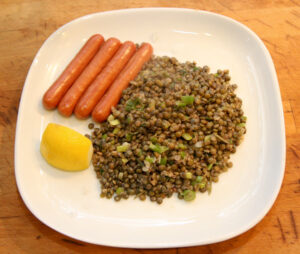How to Cook Portuguese Sausage

When it comes to comfort food and culinary adventures, nothing compares to the robust, smoky allure of Portuguese sausage. I remember the first time I encountered this mouthwatering treat; it was during a warm summer evening at a friend’s backyard barbecue. The sizzling sound as the sausage hit the grill, combined with its tantalizing aroma, left an indelible impression on me. Since then, I’ve experimented with numerous ways to prepare it, but today I want to share my insights on how to cook Portuguese sausage in a way that brings out its best flavors while keeping the process accessible and fun.
Portuguese sausage, often known as chouriço or linguiça depending on the region, carries with it a heritage steeped in tradition and local flavor. Its seasoning is simple yet bold—typically featuring garlic, paprika, and a hint of wine—and it has a texture that is both firm and succulent when cooked right. In this blog, I’ll walk you through a detailed, step-by-step guide on how to cook Portuguese sausage, including tips on achieving the perfect caramelization, ideas for pairing it with other ingredients, and answers to common questions that might pop into your mind as you embark on your culinary quest.
Understanding the Basics: What Makes Portuguese Sausage Unique?
Before diving into the cooking process, it helps to understand what sets Portuguese sausage apart. Unlike many other sausages, Portuguese sausage boasts a distinctive blend of spices and a preparation method that harks back to centuries-old recipes. Some varieties are smoked, while others remain fresh, allowing for a variety of cooking methods that can cater to different tastes and occasions.
When I first learned how to cook Portuguese sausage, I was struck by its versatility. You can grill it, bake it, fry it, or even incorporate it into stews and soups. Each method brings out different aspects of its flavor profile. For instance, grilling tends to impart a delightful char and smoky nuance, while pan-frying can help create a satisfying, crispy exterior with a tender interior.
The Art of Cooking: Step-by-Step Guide on How to Cook Portuguese Sausage
Learning how to cook Portuguese sausage doesn’t require an extensive list of ingredients or complex techniques. With a few simple steps, you can transform this humble ingredient into a centerpiece that will impress family and friends.
Step 1: Choosing and Preparing Your Sausage
Start by selecting high-quality Portuguese sausage. Whether you choose a smoked variety or a fresh one will depend on your intended recipe and personal taste. I always recommend visiting a local butcher or specialty market where you can ask questions about the sausage’s origins and ingredients. This not only ensures freshness but also provides an opportunity to learn about regional variations and traditional recipes.
Once you’ve acquired your sausage, let it sit at room temperature for about 15 minutes before cooking. This short waiting period helps the sausage to cook evenly. If the sausage comes in links, you can leave them whole or slice them into smaller pieces, depending on the dish you’re preparing.
Step 2: Prepping Your Cooking Surface
The method you choose to cook your Portuguese sausage will depend on the desired outcome. For instance, grilling gives a smoky, charred flavor that many find irresistible, while pan-frying allows for a crispier surface and easier control over the cooking process. Today, I’ll focus on the pan-frying method, but I’ll also mention alternatives along the way.
For pan-frying, heat a heavy skillet over medium heat. I prefer using cast iron for its heat retention properties, which is crucial for achieving that perfect sear. Add a small amount of olive oil to the pan—just enough to lightly coat the surface—so that the sausage doesn’t stick.
Step 3: Cooking the Sausage
Place the sausage in the skillet once the oil is shimmering. Avoid overcrowding the pan, as this can cause uneven cooking and prevent the sausage from developing a crispy exterior. Listen carefully to the gentle sizzle as the sausage makes contact with the hot surface—this sound is a good indicator that the pan is at the right temperature.
As the sausage cooks, it will start to brown. This process is called the Maillard reaction, a chemical reaction that creates complex flavors and appealing textures. Rotate the sausage every few minutes to ensure all sides are evenly browned. The goal is to achieve a uniform golden-brown exterior while ensuring the interior remains moist and juicy.
Now, if you prefer grilling, preheat your grill to medium-high heat and brush the grates with oil to prevent sticking. Place the sausage on the grill and cook for about 5-7 minutes per side until it develops grill marks and reaches an internal temperature of around 160°F (71°C).
Step 4: Finishing Touches and Flavor Enhancements
Once the sausage is cooked through, consider adding a few finishing touches to elevate its flavor. Some cooks enjoy deglazing the pan with a splash of white wine or beer after removing the sausage. This not only loosens the caramelized bits stuck to the pan but also creates a quick pan sauce that pairs wonderfully with the sausage. Pour the liquid into the hot pan and let it simmer for a minute or two, stirring to combine the flavors.
I like to sprinkle a small amount of fresh chopped parsley or a dash of smoked paprika over the finished sausage. These simple additions can brighten the dish and provide a contrast to the rich, savory flavor of the meat.
Exploring Different Recipes and Serving Ideas
One of the best things about Portuguese sausage is its versatility. Here are a few ideas that showcase how to cook Portuguese sausage in different contexts, adding variety to your meals:
Portuguese Sausage with Rice and Beans
This is a hearty dish that brings together the smoky flavor of the sausage with the simplicity of rice and the creaminess of beans. Begin by slicing the sausage into rounds and pan-frying them until nicely browned. In a separate pot, cook white rice with a pinch of salt and a dash of olive oil. Warm up some canned or pre-cooked beans, adding garlic and a touch of cumin for extra depth. Serve the sausage over the rice, spooning the beans on the side, and garnish with fresh cilantro. The combination of textures and flavors makes for a satisfying meal that’s perfect for both lunch and dinner.
Chouriço and Potatoes: A Rustic Delight
For a dish that exudes rustic charm, try pairing your Portuguese sausage with potatoes. Start by preheating your oven to 400°F (200°C). In a large bowl, toss cubed potatoes with olive oil, rosemary, garlic, salt, and pepper. Arrange them in a single layer on a baking sheet and roast until tender and crispy around the edges, usually about 25-30 minutes. Meanwhile, cook the sausage in a skillet until it develops a nice sear. Serve the sausage on top of the roasted potatoes, and drizzle with a bit of extra virgin olive oil. This dish is not only comforting but also evokes the warm, earthy flavors of a traditional Portuguese kitchen.
Portuguese Sausage Sandwiches
If you’re looking for something quick and easy, Portuguese sausage sandwiches are a great option. Slice the cooked sausage into pieces and place them in a crusty roll or baguette. Top with sautéed onions and bell peppers for a bit of sweetness, and add a dollop of mustard or a spicy aioli to enhance the overall flavor. This simple yet satisfying sandwich is perfect for a casual lunch or an on-the-go dinner.
Incorporating Sausage into Stews and Soups
Portuguese sausage also shines when added to stews and soups. Its rich, savory notes blend seamlessly with the other ingredients. One of my favorite recipes involves adding chunks of sausage to a tomato-based stew with chickpeas, kale, and a variety of herbs. Let the sausage simmer with the vegetables until all the flavors meld together, creating a comforting bowl of warmth that is ideal for a chilly evening.
Personal Reflections on Cooking Portuguese Sausage
Over the years, I’ve come to view cooking as both an art and a science, a blend of precise techniques and personal flair. How to cook Portuguese sausage has been a delightful journey for me—a path filled with experimentation, small victories, and even a few humorous kitchen mishaps. There was one memorable evening when I accidentally overcooked a batch of sausage, resulting in a texture that was a bit too firm. Instead of letting it go to waste, I sliced it thinly, added it to a stir-fry with vibrant vegetables, and discovered a surprisingly delicious new way to enjoy it.
These experiences taught me that cooking is rarely about following a recipe to the letter; it’s about embracing the process, learning from mistakes, and ultimately enjoying the meal you create. It’s that unpredictability and personal touch that makes every dish unique, every bite memorable.
Cultural Nuances and Traditions Behind Portuguese Sausage
Portuguese sausage carries a rich cultural history that extends beyond its flavor profile. In Portugal, food is celebrated as a communal experience. Meals are often shared with family and friends, and dishes like chouriço are a staple during festivals, family gatherings, and everyday dinners. The preparation of these sausages is steeped in tradition, with recipes passed down through generations.
I recall visiting a small village in Portugal years ago, where I was invited to a local feast. The host explained that the secret to a great sausage was not just in the spices, but in the careful curing process and the balance of flavors that had been perfected over time. Such cultural encounters remind us that food is more than sustenance—it’s a link to our heritage, a narrative of shared history, and a celebration of local identity.
How to Cook Portuguese Sausage in Different Kitchen Setups
Not everyone has a fully equipped kitchen. Some of us might be cooking in a small apartment, dorm room, or even an office kitchenette. The beauty of knowing how to cook Portuguese sausage is that it adapts well to various setups.
If you have access to a stove, the process described above works perfectly. For those with only a microwave at hand, consider partially cooking the sausage in the microwave to speed up the process, then finishing it off in a hot skillet or under a broiler to achieve that crisp, charred finish. I once experimented with this hybrid method when I was traveling, and it turned out to be a handy trick that saved time without sacrificing flavor.
Tips and Tricks for Perfect Portuguese Sausage Every Time
Cooking is a craft, and every craft benefits from a few secret tips. Here are some pointers to ensure that every time you ask, “How to Cook Portuguese Sausage,” you get it just right:
- Temperature Matters: Whether using a grill, pan, or oven, make sure your cooking surface is properly heated. A medium heat is usually best for even cooking without burning the exterior.
- Resting Period: Allow the sausage to rest for a few minutes after cooking. This lets the juices redistribute, making each bite more succulent.
- Experiment with Spices: Don’t be afraid to add a twist to the traditional recipe. A squeeze of citrus or a sprinkle of fresh herbs can elevate the dish, making it uniquely yours.
- Quality of Meat: The best results come from using high-quality Portuguese sausage. If you can, opt for artisanal or locally made varieties where the ingredients and curing processes are handled with care.
- Avoid Overcrowding: If cooking multiple pieces, give each sausage enough space. Overcrowding the pan can lead to steaming instead of searing, which diminishes the flavor and texture.
- Patience is Key: It’s tempting to crank up the heat when you’re in a hurry, but a steady, moderate heat is the secret to a perfectly cooked sausage that is both crispy on the outside and juicy on the inside.
Bringing It All Together
Knowing how to cook Portuguese sausage is more than just a culinary skill—it’s an invitation to explore cultural traditions, embrace the joy of cooking, and create memorable meals with loved ones. Every step of the process, from selecting the perfect sausage to adding your personal twist, contributes to a rich culinary experience that is as satisfying as it is delicious.
In today’s fast-paced world, having reliable, time-tested methods for preparing our favorite foods is a gift. The tips I’ve shared on how to cook Portuguese sausage offer a blend of traditional techniques and modern shortcuts, ensuring that whether you’re a seasoned chef or a beginner, you can enjoy a meal that feels both authentic and accessible.
Imagine sitting down with friends, plates brimming with slices of perfectly cooked sausage, the aroma filling the room as you share stories and laughter. These moments are what food is all about—connection, comfort, and the pleasure of good taste. My journey with Portuguese sausage has taken me through numerous experiments in the kitchen, and each time, I’ve discovered something new that deepens my appreciation for this flavorful treat.
Embracing the Flavor of Home
One of the things I cherish most about cooking is the way it connects me to my roots and the places I’ve been. Portuguese sausage, with its deep, savory notes and rustic charm, reminds me of sunny afternoons in small Portuguese towns where every meal is a celebration of life. Cooking it at home brings that warmth into my everyday routine, transforming an ordinary meal into a small festival of flavors.
As you try out these methods and make the recipe your own, remember that cooking is as much about the journey as it is about the destination. Don’t be afraid to experiment, to add your own spices, or to try different cooking methods until you find the one that fits your taste and lifestyle. Whether you opt for a pan-fried finish, a smoky grilled version, or even a quick microwave prep followed by a crisp finish in the skillet, each method has its own unique charm and flavor profile.
Experimentation and Future Adventures
While this guide focuses on how to cook Portuguese sausage, the culinary world is vast, and every dish is an opportunity to learn something new. I encourage you to explore other recipes that incorporate Portuguese sausage as a key ingredient. Perhaps try it in a hearty stew, combine it with a vibrant pasta dish, or even create your own signature sandwich. The possibilities are endless, and each experiment can lead to delightful surprises in flavor and texture.
I’ve often found that the best meals come from a place of curiosity and a willingness to break away from strict recipes. A few years back, I attended a cooking class where the instructor taught us innovative ways to use traditional ingredients. That experience not only enriched my knowledge of how to cook Portuguese sausage but also inspired me to be more adventurous in the kitchen overall.
The Final Word on How to Cook Portuguese Sausage
Mastering how to cook Portuguese sausage is a rewarding endeavor that goes far beyond simply following a recipe. It involves understanding the character of the sausage, embracing the cooking process, and ultimately making a dish that speaks to your personal tastes and cultural heritage. The techniques outlined here—whether pan-frying, grilling, or a hybrid method—offer reliable ways to ensure your sausage is cooked to perfection every time.
As you continue your culinary journey, keep experimenting and refining your techniques. Remember that each sausage, each spice, and every little adjustment adds a layer to your cooking story. I hope this guide has provided you with both practical advice and the inspiration to create meals that are not only delicious but also filled with memories and the warmth of tradition.
Thank you for joining me on this flavorful journey. May your kitchen be filled with the aroma of perfectly cooked Portuguese sausage and the joy of shared meals. If you have any questions or need further tips, feel free to reach out in the comments below.
FAQs
Q: Can I cook Portuguese sausage without additional oil?
A: Yes, most Portuguese sausages contain enough fat to cook without added oil, but a light brushing of olive oil can help prevent sticking and enhance the flavor.
Q: How do I know when my sausage is done?
A: Use a meat thermometer; the internal temperature should reach about 160°F (71°C). If you don’t have one, cut into a piece—the meat should be firm and juices should run clear.
Q: What’s the best way to store Portuguese sausage?
A: Keep it in the refrigerator if you plan to use it within a few days, or freeze it for longer storage. Make sure it’s tightly wrapped to maintain its flavor and prevent freezer burn.
Q: Can I cook Portuguese sausage on the grill?
A: Absolutely. Grilling imparts a lovely smoky flavor. Just make sure to oil the grates and cook over medium-high heat to avoid burning.
Q: Are there healthier ways to cook Portuguese sausage?
A: You can always bake or grill the sausage to reduce added fats. Pairing it with fresh vegetables or a light salad can balance the richness and create a healthier meal option.
Q: What’s the best method to cook Portuguese sausage if I only have a microwave?
A: You can start by microwaving the sausage for a few minutes to pre-cook it, then finish in a hot skillet or under a broiler to achieve a crisp exterior.
Q: How important is it to let the sausage rest after cooking?
A: Very important. Resting allows the juices to redistribute, ensuring a more flavorful and moist sausage.
Q: Can I add herbs and spices during the cooking process?
A: Yes, adding ingredients like garlic, smoked paprika, or a splash of wine during cooking can enhance the overall flavor.
Q: How do I know when the sausage is perfectly cooked?
A: The ideal internal temperature is around 160°F (71°C), and the exterior should be nicely browned without burning.
Q: Are there any health tips when cooking Portuguese sausage?
A: To keep it lighter, consider grilling or baking rather than pan-frying with extra oil, and serve with a side of fresh vegetables or salad.
Share this content:

A seasoned chef with over 10 years of experience in New York. I passionately share my journey and healthy, flavorful recipes online.













Post Comment